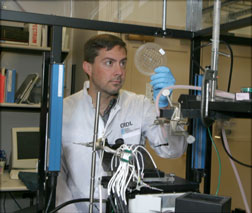NEWS RELEASES
FOR IMMEDIATE RELEASE
August 23, 2005
Sandia’s dielectrophoresis device may revolutionize sample preparation
 Sandia researcher Blake Simmons prepares a polymer
microfluidic device — known as iDEP — for use
as a particle concentrator. iDEP can deliver detectable
amounts of material in small sample volumes, eliminating
any need for overnight culturing and significantly speeding
up overall water analysis.
Sandia researcher Blake Simmons prepares a polymer
microfluidic device — known as iDEP — for use
as a particle concentrator. iDEP can deliver detectable
amounts of material in small sample volumes, eliminating
any need for overnight culturing and significantly speeding
up overall water analysis.Download 300dpi JPEG image, “idep-002.jpg,” 712K (Media are welcome to download/publish this image with related news stories.)
LIVERMORE, Calif. — Researchers at Sandia National Laboratories in California have developed an enhancement to a well known “force phenomenon” called dielectrophoresis that they say could revolutionize the way biological sample preparation is conducted. Sandia is actively seeking commercial partners to help bring the technology to the marketplace.
Sandia is a National Nuclear Security Administration laboratory.
Known as an insulator-based dielectrophoretic device (iDEP), the new tool developed at Sandia selectively — and very quickly — concentrates live pathogenic bacteria within large water samples. The technology development was internally funded through the Laboratory-Directed Research and Development (LDRD) program.
iDEP can deliver detectable amounts of material in small sample volumes, eliminating any need for overnight culturing and significantly speeding up water analysis.
In addition to water analysis, Sandia researchers say the technology may have applications beneficial to other industries. “Medical diagnostics applications might include enabling detection of diseases that produce anomalous cell morphology, such as cancer, sickle cell anemia, and leukemia,” said Carrie Burchard, a business development manager at Sandia. “In laboratories, iDEP could contribute to differential sorting of live and dead cells in cell culturing, and allow for protein isolation and concentration, sample concentration and focusing, analytical chemistry, and mass spectrometry for proteomics and drug discovery,” she said.
iDEP also could enable verification of biological decontamination efficacy for viable cell populations — as contrasted to inactivated cells and denatured proteins. For homeland security and public health purposes, it could improve water analysis and spore and vegetative cell differentiation. In industrial settings, iDEP could separate nanoparticles and nanotubes for materials synthesis.
Commercialization opportunities
Sandia scientists are actively developing application-specific
iDEP devices and architectures for concentrating and separating
bacteria, spores, viruses, and other particles.
Sandia is seeking commercial partners to further develop the technology for a variety of applications:
• To differentiate between live and dead cells for
cell culturing;
• To analyze water purity for public utilities and
public health agencies;
• To concentrate and focus samples for proteomics
research, drug discovery, homeland security, and public
health;
• To verify the efficacy of biological decontamination;
• To sort anomalous cells to diagnose diseases such
as cancer, sickle cell anemia, and leukemia; and
• To sort nanoparticles and nanotubes for materials
synthesis applications and industry.
 Sandia’s Eric Cummings visually inspects an
iDEP device for proper alignment before evaluating it with
a fluorescent microscope. Among other potential applications,
iDEP may allow for protein isolation and concentration,
sample concentration and focusing, analytical chemistry,
and mass spectrometry for proteomics and drug discovery.
Sandia’s Eric Cummings visually inspects an
iDEP device for proper alignment before evaluating it with
a fluorescent microscope. Among other potential applications,
iDEP may allow for protein isolation and concentration,
sample concentration and focusing, analytical chemistry,
and mass spectrometry for proteomics and drug discovery.Download 300dpi JPEG image, “idep-011.jpg,” 560K (Media are welcome to download/publish this image with related news stories.)
How iDEP works
First reported by Pohl in 1951, dielectrophoresis is the
movement of particles toward concentrated electric fields.
The magnitude and direction of this motion depends on the
size and shape of the particle as well as on the difference
in conductivity between the particle and the suspending
fluid. Thus, cell types can be sorted dielectrophoretically
on the basis of shape and size, and dead cells separated
from live on the basis of their higher conductivity.
Conventional dielectrophoretic sorters place electrodes within a sampling device and use the non-uniform electric field adjacent to electrodes to provoke dielectrophoretic motion of cells. Unfortunately, these electrodes require costly microfabrication, produce bubbles and electrolysis products that can harm device operation, and can damage cells with their strong field gradients.
In contrast, iDEP places electrodes outside the device. Current from the electrodes conducts through the particle-bearing liquid into the device where patterned walls or insulating obstacles produce the required non-uniform electric field. This arrangement eliminates many of the disadvantages of conventional devices: insulating structures can be replicated economically, produce no electrolytic effect, and can be contoured to be gentle on cells.
Demonstrated capabilities
iDEP devices have demonstrated the ability to perform the
following functions:
• Discriminate and separate live and dead cells
• Differentiate vegetative and sporulated cells
• Differentiate cell types
• Selectively concentrate to solid density a variety
of particles, including cells, spores, viruses, proteins,
and inert substances
• Operate in continuous and batch mode
• Concentrate particles by 104 x
In addition, Sandia researchers have demonstrated a wide range of device architectures that support the following:
• Processing of nanoliter- to liter-scale samples
• Manufacturing with a host substrate of any insulating
and impermeable material, such as glass, silica, plastic,
or ceramic
• Easy and cost-effective replication through injection
molding and hot embossing
Sandia is a multiprogram laboratory operated by Sandia Corporation, a Lockheed Martin company, for the U.S. Department of Energy’s National Nuclear Security Administration. Sandia has major R&D responsibilities in national security, energy and environmental technologies, and economic competitiveness.
Sandia media contact: Mike Janes, mejanes@sandia.gov, (925) 294-2447